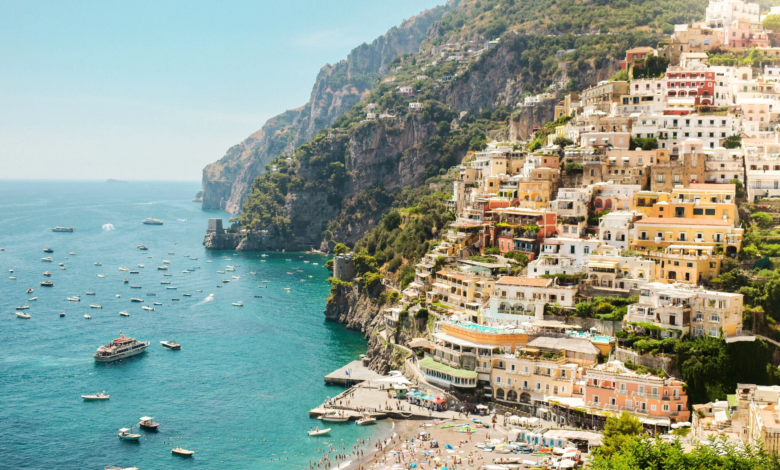Discovering Italy: An Article on Travel and Tourism

Introduction
Italy, a country steeped in history, art, and culinary excellence, is a top destination for travelers worldwide. From the ancient ruins of Rome to the romantic waterways of Venice and the rolling vineyards of Tuscany, Italy offers a captivating journey through time and culture. This article explores the magic of travel and tourism in Italy, providing essential travel tips for a seamless and enriching experience.
The Allure of Italy
Historical Wonders
Italy’s history is a treasure trove waiting to be explored.
- Rome: The Eternal City is a living museum. Stand in awe before the Colosseum, wander through the ruins of the Roman Forum, and marvel at the grandeur of the Pantheon. The Vatican City, with St. Peter’s Basilica and the Sistine Chapel, is a must-visit for its religious and artistic significance.
- Florence: The cradle of the Renaissance, Florence is home to iconic landmarks such as the Duomo, the Uffizi Gallery, and Michelangelo’s David. Every corner of this city exudes artistic brilliance.
Romantic Escapes
Italy’s cities and landscapes provide the perfect backdrop for romance.
- Venice: Glide along the canals in a gondola, explore the labyrinthine streets, and visit the stunning St. Mark’s Basilica and Doge’s Palace. Venice’s charm is timeless and enchanting.
- Amalfi Coast: With its dramatic cliffs, azure sea, and picturesque villages, the Amalfi Coast is a dream destination. Towns like Positano, Amalfi, and Ravello offer breathtaking views and romantic hideaways.
Culinary Delights
Italy’s cuisine is a celebration of flavors, regional diversity, and tradition.
- Pasta and Pizza: Savor authentic pasta dishes in Rome, such as Cacio e Pepe and Carbonara. In Naples, the birthplace of pizza, treat yourself to a classic Margherita.
- Wine and Cheese: Explore the vineyards of Tuscany and Piedmont, tasting renowned wines like Chianti and Barolo. Pair your wine with local cheeses, such as Parmigiano-Reggiano and Gorgonzola.
Travel Tips for Visiting Italy
Planning Your Trip
- Best Time to Visit: The ideal times to visit Italy are during the spring (April to June) and fall (September to October) when the weather is pleasant, and the crowds are thinner.
- Research and Booking: Use websites like TripAdvisor, Booking.com, and Expedia to research and book accommodations and activities. Consider staying in a mix of hotels, agriturismos (farm stays), and boutique B&Bs for a varied experience.
Navigating Italy
- Trains: Italy’s train network, operated by Trenitalia and Italo, is efficient and extensive. High-speed trains connect major cities, while regional trains serve smaller towns.
- Car Rental: Renting a car is ideal for exploring the countryside, such as Tuscany or the Amalfi Coast. However, driving in cities can be challenging due to traffic and limited parking.
- Public Transport: Cities like Rome, Milan, and Florence have excellent public transport systems, including buses, trams, and metros.
Cultural Insights
- Language: While many Italians speak English, learning basic Italian phrases can enhance your experience and show respect for the local culture.
- Etiquette: Dress modestly when visiting churches and religious sites. Italians value politeness, so greet people with a friendly “Buongiorno” (Good morning) or “Buonasera” (Good evening).
Culinary Adventures
- Dining Etiquette: Italians take their meals seriously. Avoid rushing through meals; instead, savor each course. Tipping is not obligatory but appreciated for excellent service.
- Local Specialties: Try regional specialties such as Risotto alla Milanese in Milan, Bistecca alla Fiorentina in Florence, and Limoncello on the Amalfi Coast.
Health and Safety
- Health Precautions: Ensure you have travel insurance that covers health emergencies. Stay hydrated, especially in the summer, and wear comfortable shoes for exploring.
- Safety Tips: Italy is generally safe, but be mindful of pickpockets, especially in crowded tourist areas. Keep your belongings secure and be cautious with your valuables.
Conclusion
Italy is a destination that captivates the senses, offering a rich blend of history, culture, romance, and culinary delights. By planning thoughtfully, navigating the country efficiently, and embracing the local culture with respect and curiosity, travelers can unlock the true magic of Italy. Whether you’re marveling at ancient ruins,

offering a plethora of fascinating historical sites to explore. Here are some must-visit historical sites in Italy that I would recommend for first-time visitors:
1. Colosseum, Rome: The iconic Colosseum is an ancient amphitheater and a symbol of the Roman Empire’s grandeur. It’s an incredible testament to Rome’s architectural and engineering prowess.
2. Pompeii and Herculaneum, near Naples: These ancient Roman cities were preserved remarkably well under layers of ash after the eruption of Mount Vesuvius in 79 AD. Walking through the well-preserved ruins offers a unique glimpse into Roman life.
3. The Vatican City, Rome: Explore the Vatican City, an independent city-state within Rome, and visit St. Peter’s Basilica, the Vatican Museums (including the Sistine Chapel), and the Vatican Gardens. It’s a center of art, religion, and history.
4. Florence Cathedral and the Uffizi Gallery, Florence: The Florence Cathedral, also known as the Duomo, is a magnificent masterpiece of Gothic architecture. Adjacent to it is the Uffizi Gallery, housing a vast collection of Renaissance art, including works by Botticelli, Michelangelo, and Da Vinci.
5. Pompeii Forum and Mount Vesuvius, near Naples: Take a guided tour of the ancient Pompeii Forum, the political and social center of the city, and then venture up Mount Vesuvius for a breathtaking view and an understanding of the volcano’s impact on the area.
6. The Leaning Tower of Pisa, Pisa: Visit the iconic Leaning Tower of Pisa, a bell tower that gained worldwide fame due to its unintended tilt. Climb to the top for a unique perspective and photo opportunity.
7. The Pantheon, Rome: The Pantheon is a well-preserved ancient Roman temple dedicated to all the gods. Its massive dome and impressive architecture make it a must-see in Rome.
8. The Sassi di Matera, Matera: Explore the ancient cave dwellings in Matera, known as the Sassi. These unique dwellings, carved into the rocks, provide a glimpse into prehistoric and medieval living conditions.
9. The Palace of Caserta, Caserta: The Royal Palace of Caserta is a magnificent Baroque palace, often referred to as the “Versailles of Italy.” Its grandeur, vast gardens, and lavish interiors make it a remarkable sight.
10. The Valley of the Temples, Agrigento: Located in Sicily, the Valley of the Temples is an archaeological site featuring well-preserved ancient Greek temples. The majesty of these ruins against the backdrop of the Mediterranean Sea is awe-inspiring.
Remember to check the opening hours, buy tickets in advance whenever possible, and consider guided tours to enhance your experience at these historical sites. Enjoy your visit to Italy’s rich historical heritage!

When planning to visit multiple historical sites during your trip to Italy, here are some tips to help you make the most of your time and experience:
- Research and prioritize: Before your trip, research the historical sites you wish to visit and prioritize them based on your interests. This will help you create a well-organized itinerary and ensure you don’t miss the must-see sites.
- Plan your route: Group the historical sites based on their geographical proximity to minimize travel time. Consider starting with sites that open early or have fewer crowds, and plan your route accordingly.
- Allocate sufficient time: Allow ample time at each site to fully appreciate and explore its historical significance. Some sites require more time than others, so be mindful of this when planning your itinerary. Consider the opening and closing times of each site to make the most of your visit.
- Purchase tickets in advance: For popular historical sites, especially those in major cities like Rome and Florence, it’s advisable to purchase tickets in advance. This will help you skip long queues and save time. Many sites offer online ticketing options, so take advantage of them.
- Consider guided tours: Guided tours can provide valuable insights and help you navigate through the historical sites more efficiently. Consider joining guided tours, especially for complex sites like the Vatican Museums or ancient ruins, to enhance your understanding and make the most of your visit.
- Be mindful of peak hours: Popular historical sites, especially during peak tourist season, can get crowded. To avoid large crowds, try visiting early in the morning or later in the day when the crowds tend to be thinner. This will allow you to enjoy the sites with more ease.
- Take breaks and pace yourself: Exploring historical sites can be physically demanding, so remember to take breaks and pace yourself. Plan rest periods or leisurely activities in between site visits to recharge and make the most of your experience.
- Use public transportation: In major cities, like Rome and Florence, consider using public transportation to commute between historical sites. It’s often a convenient and cost-effective option, especially if the sites are located relatively close to each other.
- Stay hydrated and carry snacks: It’s important to stay hydrated and energized during your visits. Carry a water bottle and some snacks to keep yourself refreshed, especially if you plan on spending long hours at the historical sites.
- Remain respectful: When visiting historical sites, remember to be respectful of the rules, regulations, and cultural norms. Follow any guidelines provided, avoid damaging any artifacts or structures, and maintain a respectful demeanor towards the historical significance of the sites.
By following these tips, you can efficiently explore multiple historical sites in Italy while maximizing your enjoyment and understanding of their cultural and historical significance.

Here are some tips for visiting historical sites in Italy while traveling on a budget:
- Research free or discounted entry: Many historical sites in Italy offer free or discounted entry on specific days or times. Research in advance to find out if there are any such offers available for the sites you wish to visit. For example, some museums and sites offer free entry on the first Sunday of every month.
- Prioritize free attractions: Italy has numerous historical sites that are free to visit. Prioritize these attractions in your itinerary. For example, in Rome, you can visit the Trevi Fountain, Spanish Steps, and Piazza Navona without purchasing tickets.
- Look for combo tickets or passes: Some cities offer combo tickets or passes that allow you to visit multiple historical sites at a discounted price. Look for city passes that include entry to popular attractions, public transportation, or guided tours. These can often save you money compared to purchasing individual tickets.
- Take advantage of student or senior discounts: If you are a student or a senior, make sure to carry your identification as many historical sites offer discounted entry for these groups. Inquire about student or senior discounts at ticket counters or check the official website of the site you plan to visit.
- Visit during off-peak seasons: Traveling during the off-peak seasons can help you save money on accommodations, transportation, and even entry fees to some historical sites. Prices are generally lower, and there are fewer crowds, allowing you to enjoy the sites more comfortably.
- Pack your own meals and snacks: Eating out at restaurants near historical sites can be expensive. Consider packing your own meals and snacks, especially for day trips. You can find local markets or grocery stores to buy fresh produce, bread, and snacks to enjoy on the go.
- Utilize public transportation: Opt for public transportation, such as buses or trains, instead of taxis or private transfers to reach historical sites. Public transportation is generally more budget-friendly, and it also provides an opportunity to experience the local culture.
- Explore free walking tours: Many cities in Italy offer free walking tours that cover historical sites. These tours are led by local guides who provide insights into the history and culture of the area. While the tours are free, it is customary to tip the guide at the end.
- Consider audio guides or self-guided tours: Instead of hiring a personal guide, consider using audio guides or self-guided tour materials available at some historical sites. These options are often cheaper and still provide valuable information about the site.
- Stay in budget accommodations: Look for budget-friendly accommodations, such as hostels, guesthouses, or vacation rentals, to save money on lodging. Consider staying slightly outside city centers, where prices tend to be lower, and use public transportation to reach the historical sites.
Remember, even on a budget, you can still explore and appreciate the historical sites in Italy. With careful planning and consideration, you can have a fulfilling and affordable experience.

When it comes to budget-friendly accommodation near major historical sites in Italy, there are several options to consider. Here are a few suggestions:
- Hostels: Hostels are a popular choice for budget travelers. They offer dormitory-style rooms with shared facilities, providing an affordable and social accommodation option. Many hostels are located near major historical sites, particularly in popular tourist cities like Rome, Florence, and Venice.
- Guesthouses and B&Bs: Guesthouses and bed and breakfast (B&B) establishments often provide affordable and cozy accommodation options. They are typically smaller and more intimate than hotels, and you can find them in various price ranges. Look for guesthouses located near the historical sites you plan to visit.
- Vacation Rentals: Consider renting an apartment or a vacation home, especially if you’re traveling with a group or staying for an extended period. Websites like Airbnb, HomeAway, and Booking.com offer a wide range of budget-friendly options, and you can often find properties located close to major historical sites.
- Budget Hotels: While hotels tend to be relatively more expensive than hostels or guesthouses, you can still find budget-friendly options, especially if you book well in advance or during off-peak seasons. Look for hotels that offer basic amenities and are located within proximity to the historical sites you wish to visit.
- Camping: If you enjoy the outdoors, camping can be a cost-effective accommodation option, particularly in rural areas or near national parks that have historical sites nearby. Italy has several campsites equipped with facilities like showers, toilets, and electricity. Check for campsites near your desired historical sites.
- Religious Accommodations: In some cities, religious institutions offer affordable accommodations to travelers. For example, in Rome, you can find convents and monasteries that provide rooms for visitors at reasonable rates. These accommodations are often simple but clean and located in central areas.
- Stay slightly outside city centers: Consider staying in neighborhoods that are slightly outside the city centers. Accommodation prices tend to be lower in these areas, and with the availability of public transportation, you can easily reach the major historical sites while enjoying more budget-friendly options.
Remember to read reviews and check the location of the accommodations to ensure they are conveniently situated near the historical sites you plan to visit. Additionally, booking in advance and being flexible with your travel dates can help you secure better deals and discounts.
Yes, ask yourself Is this travel useful yes it is very useful, but if you use it seriously when going to the following link of importance, it will save you not only money but also time together in a complete integrated system from your place and no trouble even in pricing everything that includes travel, price differences and some others



